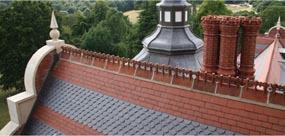Tiling

The setting out of battens needs to take into account the top and bottom of the roof and the openings through it, such as dormer windows or roof lights. The top of the roof and the bottom edge are called fixed points and the top and bottom of each opening are also defined as fixed points. The fixed points are used to calculate the batten gauge. For example, on a roof with one roofwindow, the bottom edge of the roof and the lower edge of the roof-window will be used to calculate the batten gauge between these two points, and the bottom of the roof-window and the top of the window are used to determine the batten gauge on this section of the roof, etc.
Starting at the eave of the roof a full length tile is positioned to ensure that it overlaps the gutter by 50mm and the height of the barge board adjusted, taking into consideration the thickness of the eaves tile, to ensure that the tile will lie in the same plane as the other tiles when they are placed on the roof. The position of the underside of the nibs are marked on the underlay and the process repeated at various positions along the roof. Ideally, all the marks should be in the same horizontal plane. If they are not, either one will need to be adopted as the common datum, or, a step in the tiling will need to be arranged at a suitable feature such as an abutment. Where a step is planned the difference in level should be a module of the tile gauge, which can be a maximum of 100mm. Having set out the line of the top of the first batten, it should be nailed in position.
With the first batten in position, the batten for the eaves tile (eaves / top tiles are shorter in length than a standard tiles) can be located such that there is just enough space between the bottom of the first batten and the top of the eaves tile batten to allow the head of the eaves tile, including nibs, to slide between them. Provided the tile battens are no wider than 38mm the eaves tile should not hang lower than the first tile course.
Rising up the roof, identify the first fixed point; which in the example would be the lower edge of the roof-window. The top tile course (using eaves / top tiles) is set out to allow the head of the top tile, including the nibs, to fit under the windowsill. With the batten in place, the last full tile batten can be located to allow just enough space between the bottom of the top tile batten and the top of the last full tile batten, to allow the last full tile to slide between them. Provided the tile batten is no wider than 38mm the top tile should provide adequate cover for the last full tile course. If the distance between the eaves course and the first fixed point is relatively short (less than 450mm) it may be difficult to set a gauge that reaches the windowsill and a decision to have a longer flashing may need to be made.
Between the top of the first and the last full tile courses of any fixed points, the intermediate battens will need to be set out to ensure that the gauge; which is the distance from the top of one batten to the top of the next batten, is not greater than 100mm. This is achieved by measuring the overall gauge distance and dividing it by 100mm. The answer to the caluculation will be a whole number and a decimal point. Whatever the whole number is, increase it by one and divide that number into the gauge distance. The answer to this calculation will provide the gauge to which the intermediate battens should be set.
The next fixed point in the roof needs to be identified and in the example this would be the top of the roof-window and set out depending upon whether it is a bottom edge or top edge, and the battens between them gauged out equally until the last full tile batten is reached.
The top of the roof has the top course (using eaves / top tiles) set out to allow the head of the top tile, including the nibs, to fit under the ridge. Once this batten is in place, the last full tile batten can be located to allow just enough space between the bottom of the top tile batten and the top of the last full tile batten, to allow the last full tile to slide between them. Provided the tile batten is no wider than 38mm the top tile should provide adequate cover for the last full tile course.
All tile battens should be horizontal (level) and straight, with no sags. No batten should be less than 1200mm long. Joints should be square cut and butted centrally over rafters and must not occur more than once in any group of 4 battens on any one support.
Having set out and nailed all the battens the setting out of tiles on each batten needs to be considered. Each plain tile is 165mm wide and should have a gap of up to 3mm between them. The first whole course of tiles should be set out to equalise all the gaps between the tiles, start and finish at corner or abutments and line up with the sides of window openings. Having settled on an arrangement, the batten should be marked every third or fifth joint. Near the last full tile course, the process should be repeated and plumb lines dropped to ensure that the tile joints are vertical, and the battens marked.
The eaves course of tiles are laid broken bond to the first full course of tiles so may need an eaves tile and half; these can be made by cutting a full tile-and-a-half down to the same length as the eaves tile. The same may apply at the top tile course and is more critical since it is more visible.
At roof-window reveals it may be necessary to finish with a cut tile-and-a-half on each course to maintain the vertical perpendicular joints.
Tiles should always be mixed from at least three pallets to ensure that any variations in shade and colour give an aesthetically pleasing effect.







-A.jpg)


